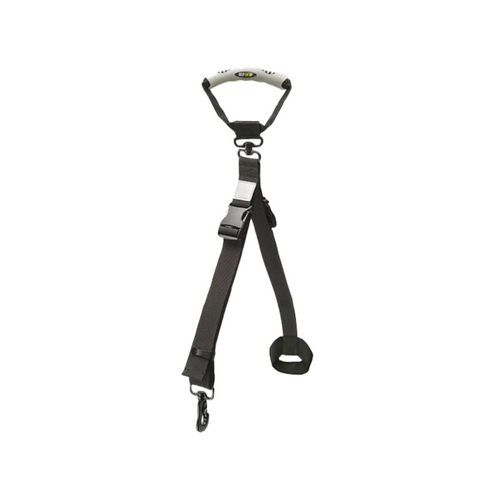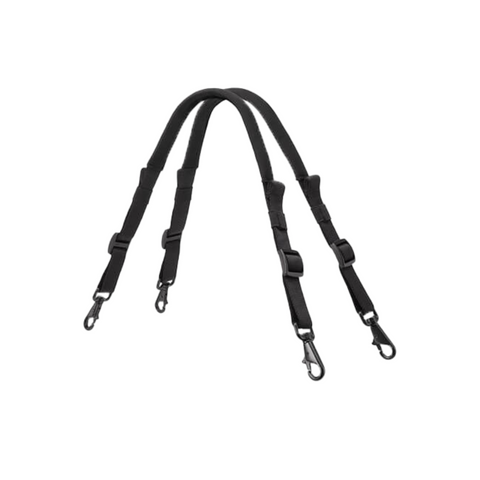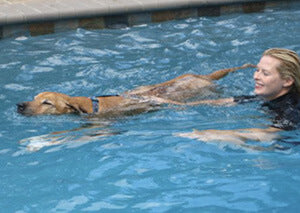If you have ever had a hip or knee replacement, you know that physical therapy is in your future. It is an integral component of the rehabilitation process, one that will help restore your mobility and strength.
What is Canine Rehabilitation?
Actually canine rehabilitation often mirrors that of humans. According to the Whole Dog Journal: “Veterinary rehabilitation uses many of the same modalities and techniques for animals as physical therapy does for humans.”
The onset of Flyball, Frisbee golf and agility trials have made canine therapy more popular than ever before. Introduced in Europe in the 1980s, it is known as Animal Assisted Therapy or AAT here in the United States. It is not exclusively for senior dogs, because younger dogs may be facing an injury or recovering from an accident. And it’s not just for dogs but horses, cats, rabbits and even birds as well.
Physical therapy is often advised for pets suffering from joint, spinal cord, and soft tissue injuries, osteoarthritis and pain, inflammation, hip and elbow dysplasia, and other conditions from old age. It combines physics, biomechanics, anatomy, physiology and psychology.
Advantages of Dog Rehabilitation
- Increases range of motion and flexibility
- Strengthens weakened muscles
- Reduces pain
- Improves mobility
- Speeds recovery process
- Develops a better quality of life
- Decreases weight if pets are overweight
Most Common Types of Canine Physical Therapy
- Aquatic therapy (Hydrotherapy). Water therapy may involve swimming or using an underwater treadmill. It has been found to reduce swelling, strengthen muscles and range of motion, increase endurance, encourage weight loss, and decrease pain. Because dogs like humans are more buoyant in water, both the joint stress and pain is often less. The water also offers resistance for muscle strengthening.
- Massage. This form of therapy is widely used to increase a dog’s circulation, which in turn promotes healing and decreases pain.
- Cold therapy (cryotherapy) can help to reduce inflammation and swelling, muscle spasms, and also pain.
- Heat therapy is often used to help reduce muscle spasms and pain, lower blood pressure and improve circulation.
- Ultrasound. Primarily, ultrasound allows for deep, penetrating heating of the target area in a way that spares the outer tissues (i.e., skin) from damage. It also can penetrate deeper than topical heat alone.
Types of Conditions Physical Therapy Can Help
- ACL or CCL injuries
- Amputation recovery
- Arthritis or joint pain
- Athletic injuries
- Disc conditions
- Hip and elbow dysplasia
- Muscle tears or pulls
- Nerve disorders
- Neurological disorders such as degenerative myelopathy
- Postsurgical recovery of the knees, hip, back or neck
- Rear limb weakness
- Trauma
Please do not attempt or initiate any physical therapy at home without first discussing it with your vet and to identify a certified professional. If you are looking for a qualified physical therapist, check to see if they are a CCRP (certified canine rehabilitation practitioner), a CCRT (certified canine rehabilitation therapist) or a CVT (certified veterinary technician) under the supervision of a CCRP. It’s a relatively new field and is becoming increasingly popular!
Understand that physical therapy is NOT a cure but a means to let your dog live a more functional life. It is even good for healthy dogs just to get regular exercise, particularly if you live in an area where the cold prohibits outdoor activities.
Animal physical therapy can make a BIG difference in the quality of your pet’s life. Our Help ’Em Up harness can be used on dogs overcoming surgery or those who require rehab. Our lifting harness helps owners whose dogs are feeling the effects of aging or health issues, along with Veterinarians, and Orthopedic Surgeons who work with dogs recovering from injuries or surgery.
Take the case of Henry James. As his pet parent says: “I purchased your Helpemup for my 11 year-old, 110 lb. Rhodesian Ridgeback, Henry James. Henry had a total hip replacement. As a canine physical therapist, I have access to a myriad of devices that are allegedly supposed to make the job of carting around a 100+ lb. dog easier – products I’ve often recommended to my clients as well. The best thing (and the ONLY thing that really worked with a reasonable degree of success) I’ve found is your harness. I can now lift Henry into a standing position by myself (until now it has been a 2-person operation) and he outweighs me! The other major benefit of your harness is that it allows the dog to place his feet correctly and actually walk without the hindrance of a sling.”
It is important for you and your physical therapist to set realistic goals. A 2-year old dog may be back to walking miles a day in no time, but a senior dog may take longer to improve. Because dogs can’t tell us they are in pain, the most important thing a pet parent can do is to be aware of any issues your dog may be having. Then you and your vet can decide whether physical therapy is the route you want to go.



